Pargya tested the solubility of four different substances at different temperatures and collected the data as given below (results are given in the following table as grams of substance dissolved in 100 grams of water to from a saturated solutin).

(a) What mass of potassium nitrate would be needed to procuce a strurated solution of potassium nitrate in 50 grams of water at 313 K ?
(b) Pragya makes a saturated solution of potassium chloride in water at 353 K and leaves the solution to cool at room temperature. What would she observe as the solution cools ? Explain.
(c ) Find the solubility of each salt at 293 K. Which salt has the highest solubility at this twmperature?
(d) What is the effect of change in temperature on the solubility of a salt ?
(a) The solubility of potassium nitrate at 313 K is 62 grams (see the given table). This means that 62 grams of potassium nitrate is needed to make a saturated solution of potassium nitrate in 100 grams of water at 313 K. So, to make a saturated solution in 50 grams of water we eill need half of 62 grams of potassium nitrate, which is 622=31 grams of potassium nitrate.
(b) When a saturated solution of potassium chloride at 353 K is left to cool, then solid potassium chloride (or crystals of potassium chloride) will gradually separate out from thr solution (because the solubility decreases on cooling).
(c )The solubility of various salts at 293 K is: Potassium nitrate 32 g, Sodium chloride 36 g, Potassium chloride 35 g, and Ammonium chloride 37 g. Ammonium chloride has the highest solubility (of 37 g) at this temperature of 293 K.
(d) The given data shows that the solubility of a salt increases on increasing the temperature.
Topper's Solved these Questions
- BOOK - LAKHMIR SINGH & MANJIT KAURCHAPTER - IS MATTER AROUND US PURE EXERCISE - Questions based on high order thinking skills (HOTS)3videos
IS MATTER AROUND US PURE
- BOOK - LAKHMIR SINGH & MANJIT KAURCHAPTER - IS MATTER AROUND US PURE EXERCISE - QUESTIONS BASED ON HIGH ORDER THINKING SKILLS (HOTS)1videos
IS MATTER AROUND US PURE
- BOOK - LAKHMIR SINGH & MANJIT KAURCHAPTER - IS MATTER AROUND US PURE EXERCISE - NCERT BOOK PAGE 241videos
IS MATTER AROUND US PURE
- BOOK - LAKHMIR SINGH & MANJIT KAURCHAPTER - ATOMS AND MOLECULESEXERCISE - Exercise205videos
ATOMS AND MOLECULES
- BOOK - LAKHMIR SINGH & MANJIT KAURCHAPTER - MATTER IN OUR SURROUNDINGS EXERCISE - NCERT26videos
MATTER IN OUR SURROUNDINGS
Similar Questions
Pragya tested the solubility of three different substances at different temperatures and collected the data as given below (results are given in the following table, as grams of substance dissolved in 100 grams of water to form a saturated solution).
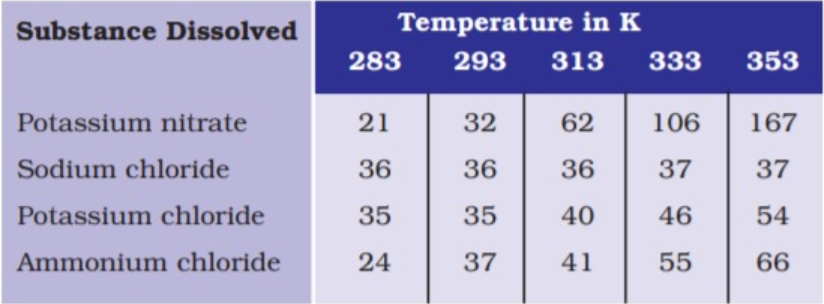
(a) What mass of potassium nitrate would be needed to produce a saturated solution of potassium nitrate in 50 grams of water at 313 K ?
(b) Pragya makes a saturated solution of potassium chloride in water at 353 K and leaves the solution to cool at room temperature. What would she observe as the solution cools ? Explain.
(c ) Find the solubility of each salt at 293 K . Which salt has the highest solubility at this temperature ?
(d) What is the effect of change of temperature on the solubility of a salt ?View SolutionPragya tested the solubility of three different substances at different temperatures and collected the data as given below (results are given in the following table, as grams of substance dissolved in 100 grams of water to form a saturated solution).
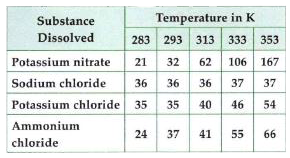
What mass of potassium nitrate would be needed to produce a saturated solution of potassium nitrate in 50 grams of water at 313 K?View Solution
Knowledge Check
- Question 1 - Select One
0.1 gram mole of urea dissolved in 100 g of water. The molality of the solution is
A1 mB0.01 MC0.01 mD1.0 M - Question 2 - Select One
10 grams of a solute is dissolved in 90 grams of a solvent. Its mass percent in solution is
A0.01B11.1C10D9
Pragya tested the solubility of three different substances at different temperatures and collected the data as given below (results are given in the following table, as grams of substance dissolved in 100 grams of water to form a saturated solution).
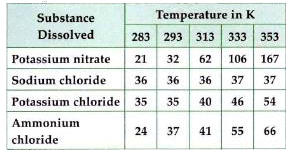
What is the effect of change of temperature on the solubility of a salt?View SolutionPragya tested the solubility of three different substances at different temperatures and collected the data as given below (results are given in the following table, as grams of substance dissolved in 100 grams of water to form a saturated solution).
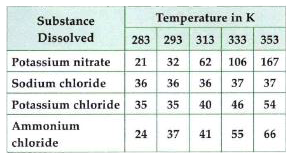
Find the solubility of each salt at 293 K. Which salt has the highest solubility at this temperature?View SolutionPragya tested the solubility of three different substances at different temperatures and collected the data as given below (results are given in the following table, as grams of substance dissolved in 100 grams of water to form a saturated solution).
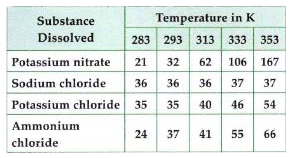
Pragya makes a saturated solution of potassium chloride in water at 353 K and leaves the solution to cool at room temperature. What would she observe as the solution cools? Explain.View SolutionSolubility of KNO3at 313 K is 62 g. What mass of KNO3 would be needed to produce a saturated solution of KNO3 in 50 g of water at 313 K ?
View SolutionA student , determined the solubility of four substabces ,potassium nitrate ,sodium , sodim choride ,potassium choride and ammonium choride in a water at five different temperatures of 10∘C,20∘(C40∘C,60∘C and 80∘C and obtained the following data :

(a) what mass of potassium nitrate woulds be needed to make a satured solution of potassium nitrate in 50 grams of water at 40∘C? (b) what would be observed if a saturated solution of potassium choride at 80∘C is left to cool to the room temperature ?
( c) what is the solubilty of each salt at 20∘C ? which salt has the highest solubility at this temperature ?
(d) what is the effect of change of temperature on the solbubility of a salt as shown by the above date?View SolutionAnkita tested the solubility of four different substances (I-IV) at different temperatures and collected the data as given in the table.

Fill in the blanks by selecting the correct option. __(x)___ of substance III would be needed to produce a saturated solution of it in 50 grams of water at 40∘C. ___(y)___ has the highest solubility at 20∘C while ___(z)___ has the least solubility at 10∘C.
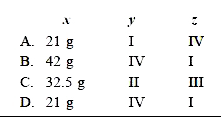 View Solution
View Solution

